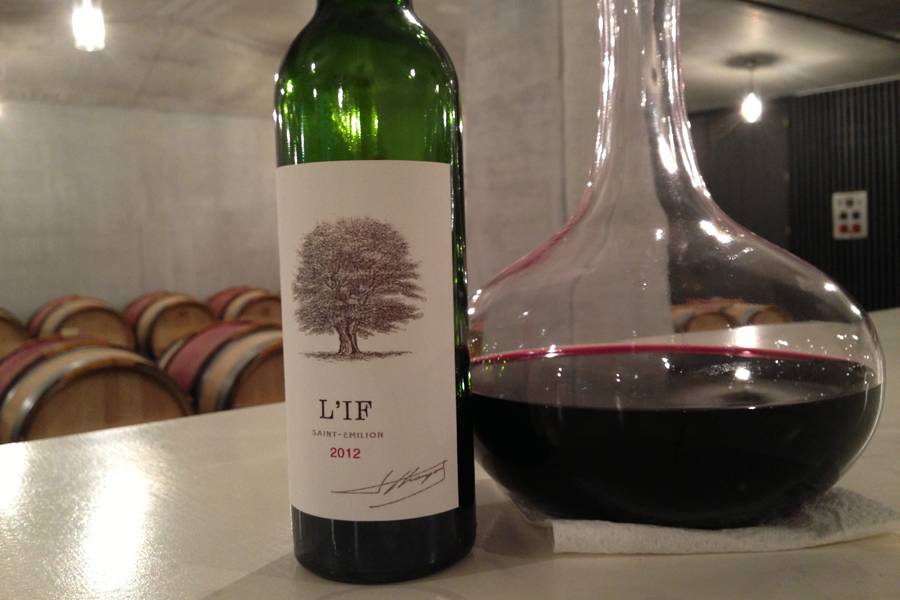- Colour Red
- Producer Château l'If
- Region St Emilion
- Drinking 2026 - 2038
- Case size 6x75cl
- Available Now
2018 - L'If St Emilion - 6x75cl
- Colour Red
- Producer Château l'If
- Region St Emilion
- Drinking 2026 - 2038
- Case size 6x75cl
- Available Now
Select pricing type
Need help? Call +44 (0)20 7793 7900 or email wine@goedhuiswaddesdon.com.
-
Neal Martin, March 2021, Score: 92
The 2018 L’If, which sees 50% new oak and 50% one-year-old wood, has a disarmingly lovely bouquet that veers more toward red fruit than black, offering raspberry and wild strawberry, hoisin and light marmalade aromas. The palate is medium-bodied with grainy tannins and quite saline on the entry, with good tension from beginning to end. Harmonious and almost understated toward the finish, it leaves light white pepper and sage notes on the aftertaste. This is an excellent L’If that should give 12–15 years of drinking pleasure. 2023-2035
-
Neal Martin, November 2019, Score: 90-92
The 2018 L’If is matured in 50% new oak and 50% one-year old wood, picked between 1 and 8 October. It has a very pure and sensual bouquet with dark cherries, bergamot, a touch of hoisin developing with time. The palate is medium-bodied with fine tannins, a lovely saline note with a vibrant and quite persistent finish. This is already showing commendable cohesion. A touch of spice develops with aeration. Excellent.
-
Antonio Galloni, March 2021, Score: 97
The 2018 L'If is super-impressive, even if it comes across as a bit restrained today. Ultimately, that energy will serve it well. Dark and sensual, with striking aromatic presence and fabulous balance, the 2018 dazzles from start to finish. Dark cherry, plum, spice, new leather, menthol and mocha all build in the glass. The 2018 is bold, sumptuous and full of energy. I can't wait to see how it ages. What a wine. 2028-2048
-
Antonio Galloni, April 2019, Score: 95-98
The 2018 L'If is an exceptionally beautiful Saint-Émilion. Fragrant and light on its feet, the 2018 is all finesse. A rush of rose petal, lavender, mint, spice and blue/purplish berry fruit infuse this striking, mid-weight Saint-Émilion. This is one of the more polished, understated wines of the vintage. Silky tannins add to the wine's air of sophistication. I tasted the 2018 from six separate lots and then the final blend (two times), which once again shows how important blending is as the final wine is truly greater than the sum of its parts. Cyrille Thienpont told me the grapes did not have a lot of juice at crush, so he opted for gentler winemaking and fewer pumpovers during a cuvaison that lasted 25-28 days. The blend is 74% Merlot and 26% Cabernet Franc, a big increase over 2016, where the Franc was 9%.
Producer
Château l'If

Region
St Emilion
South of Pomerol lies the medieval, perched village of St Emilion. Surrounding St Emilion are vines that produce round, rich and often hedonistic wines. Despite a myriad of soil types, two main ones dominate - the gravelly, limestone slopes that delve down to the valley from the plateau and the valley itself which is comprised of limestone, gravel, clay and sand. Despite St Emilion's popularity today, it was not until the 1980s to early 1990s that attention was brought to this region. Robert Parker, the famous wine critic, began reviewing their Merlot-dominated wines and giving them hefty scores. The rest is history as they say. Similar to the Médoc, there is a classification system in place which dates from 1955 and outlines several levels of quality. These include its regional appellation of St Emilion, St Emilion Grand Cru, St Emilion Grand Cru Classé and St Emilion Premier Grand Cru Classé, which is further divided into "A" (Ausone and Cheval Blanc) and "B" (including Angélus, Canon, Figeac and a handful of others). To ensure better accuracy, the classification is redone every 10 years enabling certain châteaux to be upgraded or downgraded depending on on the quality of their more recent vintages.




